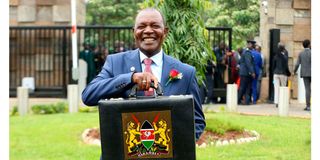
Treasury Cabinet Secretary Njuguna Ndung’u (left) and President William Ruto. By introducing a new arithmetic formula, CS Ndung’u is seeking to quietly force Parliament to cede the powers of setting the public debt ceiling from its members – the elected representatives of the people – to armchair-sitting bureaucrats at the National Treasury.
| DPPSWeekly Review
Premium
President Ruto’s first budget: Treasury CS Njuguna Ndung’u’s gamble of a lifetime
By introducing a new arithmetic formula, Cabinet Secretary Njuguna Ndung’u is seeking to quietly force Parliament to cede the powers of setting the public debt ceiling from its members – the elected representatives of the people – to armchair-sitting bureaucrats at the National Treasury.
Under the new formula, which his ministry has introduced under an amendment of the Public Finance and Management Act, the public debt ceiling will no longer be fixed, but a moveable target calculated by number crunchers at the Treasury.
This is how the CS explained it away during his budget speech on Thursday in Paragraph 89. “Mr Speaker, Sir, the current limit as approved in 2022 in the House is Sh10 trillion.
The government wants to change the public debt ceiling from a numerical number to a debt anchor in the form of a ratio of public debt to GDP in present value terms.
The proposed change to the public debt ceiling provides an appropriate guide for optimal levels of public debt based on the country’s ability to pay. This is the debt carrying capacity that can be objectively assured as well as provide direction on information on debt accumulation or reduction from time to time.”
He continued in Paragraph 90: “In order to anchor the debt ceiling in a statute, the National Treasury has developed a Public Finance Amendments Bill which has been submitted to this House. I urge members to prioritise and consider this Bill favourably.”
Why would the government want to remove this important check on profligate borrowing by the Executive and give the National Treasury unfettered discretion to its heart’s delights?
According to Prof Ndung’u, the new arithmetic formula and the anchor he has proposed is “best international best practice”. Many readers are familiar with the recent debt ceiling shoot-out between the US Congress and President Biden over a fixed numerical debt ceiling of $31.4 trillion.
The fix the US Secretary of the Treasury Janet Yellen found herself in was that she could not borrow a single dollar above the ceiling. The US risked defaulting on debt for the first time in its history. The President and the Republican majority in Congress had to trade concessions.

National Treasury Cabinet Secretary Njuguna Ndung’u at Parliament Buildings for the reading of the 2023/24 Budget Statement on June 15, 2023.
The lesson from the US is that the best practice is that the ultimate responsibility over the debt ceiling rests with the people’s elected representatives – and not a minister nor left to be derived from complex anchors calculated on the basis of arithmetic formulae or algorithms.
Between a rock and a hard place
In a sense, Prof Ndung’u had found himself between a rock and a hard place. He was caught in a bind. With his budget factoring a deficit of Sh718 billion, he knew that this year’s budget would bust the Sh10 trillion debt ceiling. Indeed, with the stock of debt at Sh8.6 trillion, the headroom was a mere Sh400 billion.
With the opposition already making too much noise about the taxation proposals contained in the Finance Bill, a fight over the debt ceiling like we had recently witnessed between the US Congress and President Joe Biden is a prospect he had to avoid. And the prospect of the budget being held hostage by a stand-off over the debt ceiling had to be avoided.
The solution? Shift from a system where the debt ceiling is determined by a fixed numerical limit of Sh10 trillion to what he calls a debt anchor. Were some hawk-eyed MP to take the matter up, we must be brave for a stand-off. And the stakes are high indeed because unless the new amendment to the Public Finance Management Act is passed and approved, questions might arise about the legality of the whole spending programme.
Under the new formula, the National Treasury has introduced under an amendment of the Public Finance and Management Act, the public debt ceiling will no longer be fixed, but a moveable target calculated by number crunchers at the Treasury.
This brings us to the second question about this year’s budget. Do the numbers add up? The CS is hoping to collect Sh2.9 trillion in revenues, which is approximately Sh1 trillion more than we collected this year. It is the biggest gamble in this year’s budget.
In a context of shrinking revenues, without a comprehensive retrenchment programme and a strategy for pruning low-priority projects across all ministries, the assumption by the minister that the budget deficit will come down to a level of 4.4 per cent of GDP is plainly unrealistic.
The wage bill and salaries as a share of government expenditure, are significantly above the levels in most African countries.
In the private sector, trends show that profits of our large and profitable banks have stagnated since 2014 – while non-performing loans are also on an upsurge. Cement production is on the decline, while per capita consumption of electricity by industrial users, a key proxy for GDP growth – has also stagnated.
Indeed, Kenya is yet to return to the high growth rates of the early parts of former President Mwai Kibaki’s administration. It remains a low-growth, low-private investment economy characterised by stagnant productivity and dwindling investment by the private sector. Corporate spending on new assets and accumulation of investment assets remained weak and stunted.
The enduring lesson we have learnt is that high government spending on infrastructure cannot compensate for an underperforming private sector. We are also learning that while debt expansion – private as well as public – can keep the economy ticking and create the appearance of recovery, debt-financed growth has its limits.
Kenya has stretched the tools of crisis management – fiscal restraint, expansion, monetary easing – to elastic limits. Until the government goes back to reviving the economy’s traditional engines of production, namely, agriculture, agriculture and export sector, the economy will persistently remain in stagnant growth mode.





